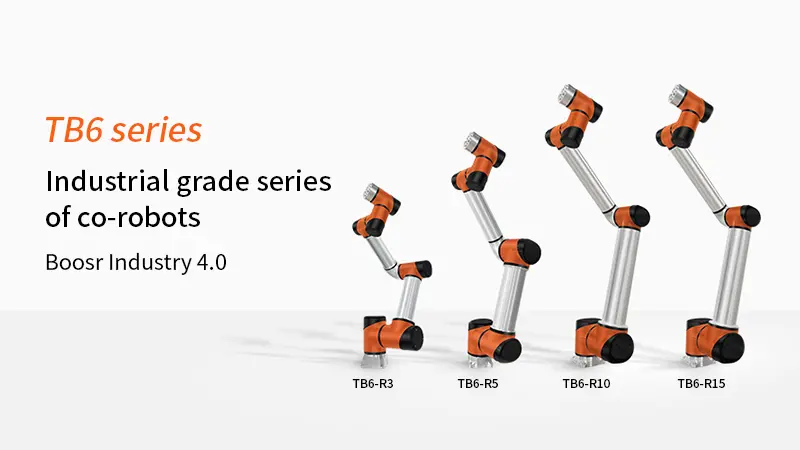Why do enterprises need co-robots, and which co-robot can meet the needs of small and medium-sized enterprises?
Date:2020-07-13
For the application of robots in the production process of enterprises, people will naturally think of the traditional industrial robots in large factories, which need fence protection and are bulky and heavy.
Traditional industrial robots are generally isolated and independent of humans and are mainly used in large-scale factory specific scenarios. The advantages are fast, high precision, and a high degree of automation; the disadvantages are also obvious, high investment, high deployment costs, and insufficient flexibility. Only large manufacturers can afford it.
SMEs are aware that the deployment cost of traditional industrial robots is too high to meet their own cost control needs. With the rapid development of Industry 4.0, the demand for robots in the diversified and customized production represented by the 3C industry has increased significantly. Flexible production is an inevitable trend. Traditional industrial robots cannot meet market demands, and co-robots have emerged.
As a professional co-robot manufacturer-Techrobots(Shenzhen), for the practical application of co-robots in enterprises, we have summarized the following advantages of co-robots:
Simple installation and flexible deployment
First, there is no need for special construction transformation and deployment of the factory area like traditional industrial robots. It can be installed at any angle according to actual production needs and quickly deployed to the table. Simple and flexible 1-2 people can complete the deployment work, and the space required is small;
Second, the automated production line using co-robots can be adjusted at any time, redeployed according to the production needs of the factory, and quickly change the production tasks and methods.
Low cost, saving labor cost
The price of the robot's body is low, and the deployment is simple, which saves a lot of costs for the traditional industrial robot to transform and deploy the factory. The investment return period is short, and a co-robot can replace 2-3 employees, reducing personnel costs. Co-robots can also adjust deployment according to production task requirements, achieve first-line multi-production, and further improve the return on investment.
Safe and secure operation
Safe operation, using advanced sensors, proactively sensing and adapting to changing environments, ensuring the safety of interaction with humans, humans, and co-robots work in a common space, and no isolation measures such as guardrails are required to ensure the process of human-computer integration The safety of employees.
Simple programming, plug, and play
No professional co-robot programmers are required. Ordinary staff can also quickly learn the programming operation of the robot and apply it to actual production, quickly connect to other automation equipment; can realize human-computer interaction, reduce the threshold of use, reduce time and cost.
Traditional industrial robots are generally isolated and independent of humans and are mainly used in large-scale factory specific scenarios. The advantages are fast, high precision, and a high degree of automation; the disadvantages are also obvious, high investment, high deployment costs, and insufficient flexibility. Only large manufacturers can afford it.
SMEs are aware that the deployment cost of traditional industrial robots is too high to meet their own cost control needs. With the rapid development of Industry 4.0, the demand for robots in the diversified and customized production represented by the 3C industry has increased significantly. Flexible production is an inevitable trend. Traditional industrial robots cannot meet market demands, and co-robots have emerged.
As a professional co-robot manufacturer-Techrobots(Shenzhen), for the practical application of co-robots in enterprises, we have summarized the following advantages of co-robots:
Simple installation and flexible deployment
First, there is no need for special construction transformation and deployment of the factory area like traditional industrial robots. It can be installed at any angle according to actual production needs and quickly deployed to the table. Simple and flexible 1-2 people can complete the deployment work, and the space required is small;
Second, the automated production line using co-robots can be adjusted at any time, redeployed according to the production needs of the factory, and quickly change the production tasks and methods.
Low cost, saving labor cost
The price of the robot's body is low, and the deployment is simple, which saves a lot of costs for the traditional industrial robot to transform and deploy the factory. The investment return period is short, and a co-robot can replace 2-3 employees, reducing personnel costs. Co-robots can also adjust deployment according to production task requirements, achieve first-line multi-production, and further improve the return on investment.
Safe and secure operation
Safe operation, using advanced sensors, proactively sensing and adapting to changing environments, ensuring the safety of interaction with humans, humans, and co-robots work in a common space, and no isolation measures such as guardrails are required to ensure the process of human-computer integration The safety of employees.
Simple programming, plug, and play
No professional co-robot programmers are required. Ordinary staff can also quickly learn the programming operation of the robot and apply it to actual production, quickly connect to other automation equipment; can realize human-computer interaction, reduce the threshold of use, reduce time and cost.
